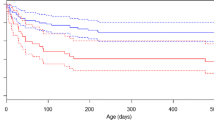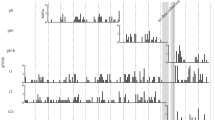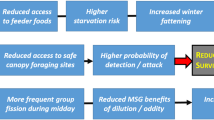Summary
Social groups of alpine marmots (Marmota marmota) were studied for 7 years. The groups consisted of a territorial pair and up to 18 lower ranking animals of various ages, mostly the pair's offspring (Tables 1, 2). Group members lived in a common home range and always hibernated together in one hibernaculum. Groups with older, subordinate animals experienced slightly higher summer mortality but significantly reduced winter mortality (Fig. 1). Infant winter mortality was further decreased if most older subordinates were potentially their full sibs (Fig. 2). Subordinate group members lost less mass during winter with increasing size of the hibernating group, but this trend was reversed when infants were present. Furthermore, augmented mass loss due to low hibernaculum quality became evident (Fig. 3). Apart from these effects, the presence of infants caused additional mass loss in potential full sibs. The opposite was found in subordinates certainly descending from other parents than those of the infants (Table 3).
Winter mortality and mass loss data revealed (i) a general benefit of joint hibernation, (ii) an unavoidable cost of infants' presence to other group members, (iii) that only potential full sibs helped in warming infants, (iv) that helping was energetically expensive and increased infant survival. The evolution of postponed dispersal in ground-dwelling squirrels has been attributed to the direct fitness gained by enhanced reproductive chances of offspring when not expelled from the natal territory (Armitage 1981, 1987, 1988). This study shows that group living in alpine marmots has benefits during winter and indicates the additional importance of kin selection in marmot social evolution.
Similar content being viewed by others
References
Armitage KB (1981) Sociality as a life-history tactic of ground squirrels. Oecologia 48:36–49
Armitage KB (1987) Social dynamics of mammals: reproductive success, kinship and individual fitness. Trends Ecol Evol 2:279–283
Armitage KB (1988) Resources and social organization of ground-dwelling squirrels. In: Slobodchikoff CN (ed) The ecology of social behavior. Academic Press, San Diego, pp 131–155
Armitage KB, Downhower JF (1974) Demography of yellow-bellied marmot populations. Ecology 55:1233–1245
Armitage KB, Downhower JF, Svendsen GE (1976) Seasonal changes in weights of marmots Am Midl Nat 96:36–51
Arnold W (1986) Sozioökologie des Alpenmurmeltieres. Dissertation, Ludwig-Maximilians-Universität München
Arnold W (1988) Social thermoregulation during hibernation. J Comp Physiol B 158:151–156
Arnold W (1990) The evolution of marmot sociality: I. Why to disperse late? Behav Ecol Sociobiol 27:229–237
Barash DP (1973) The social biology of the olympic marmot. Anim Behav Monogr 6:171–249
Barash DP (1976) Social behaviour and individual differences in free-living alpine marmots (Marmota marmota). Anim Behav 24:27–35
Barnes BM (1984) Influence of energy stores on activation of reproductive function in male golden-mantled ground squirrels. J Comp Physiol B 154:421–425
Bibikow DI (1968) Die Murmeltiere. Die neue Brehm Bücherei, Ziemsen, Stuttgart
Brown JL (1978) Avian communal breeding systems. Annu Rev Ecol Syst 9:123–155
Brown JL (1983) Cooperation - a biologist's dilemma. In: Rosenblatt JS, Hinde RA, Beer C, Busnel MC (eds) Advances in the study of behavior. Academic Press, New York, pp 1–37
Davis DE (1976) Hibernation and circannual rhythms of food consumption in marmots and ground squirrels. Q Rev Biol 51:477–514
Emlen ST (1982a) The evolution of helping. 1. An ecological constraints model. Am Nat 119:29–39
Emlen ST (1982b) The evolution of helping. 2. The role of behavioral conflict. Am Nat 119:40–53
Forter D (1975) Zur Ökologie and Verbreitungsgeschichte des Alpenmurmeltieres im Berner Oberland. Dissertation, Universität Bern
Frisch RE (1985) Fatness, menarche, and female fertility. Perspect Biol Med 28:611–633
Geiser F, Kenagy GJ (1988) Torpor duration in relation to temperature and metabolism in hibernating ground squirrels. Physiol Zool 61:442–449
Grizzell RA (1955) A study of the southern woodchuck, Marmota monax monax. Am Midl Nat 53:257–293
Hembeck H (1958) Zum Paarungsverhalten der Murmeltiere. Z Jagdwiss 4:40–41
Hofer S, Ingold P (1984) Die Pfiffe des Alpenmurmeltieres. Form und Auftreten im Zusammenhang mit der Feindvermeidung. Rev Suisse Zool 91:861–865
Holmes WG (1984) The ecological basis of monogamy in Alaskan hoary marmots. In: Murie JO, Michener GR (eds) The biology of ground-dwelling squirrels. University of Nebraska Press, Lincoln, pp 250–274
Holmes WG (1988) Body fat influences sexual maturation in captive male Belding's ground squirrels. Can J Zool 66:1620–1625
Hoogland JL (1981) The evolution of coloniality in white-tailed and black-tailed prairie dogs (Sciuridae: Cynomys leucurus and Cynomys ludovicianus). Ecology 62:252–272
Hoogland JL (1983) Nepotism and alarm calling in the black-tailed prairie dog (Cynomys ludovicianus). Anim Behav 31:472–479
Ismagilov MI (1956) Material on the ecology of the Tien-Shan marmot. (Marmota bobac centrafs Thom.). Zool Zh 35:908–915
Johns DW, Armitage KB (1979) Behavioral ecology of alpine yellow-bellied marmots. Behav Ecol Sociobiol 5:133–157
Jones RJA, Court MN (1980) The measurement of mean temperatures in plant and soil studies by the sucrose inversion method. Plant Soil 54:15–31
Kapitonov VI (1978) Data on winter diggings of Marmota camtschatica Pall. in the North-western Verkhoyanye (Yakutia). Bull Moscow Soc Natural, Biol Ser 83:43–51
Kapitonov VI, Lobachev IS (1964) Ecological observations on Marmota menzbieri Kaschk. in the Karzhantau mountains (West Tien-Shan). Zool Zh 43:1211–1220
Koenig L (1973) Marmota marmota (Sciuridae) Paarungsverhalten. In: Wolf G (ed) Encyclopaedia cinematographica E 459/1962. Institut für den wissenschaftl. Film, Göttingen
Lee R (1969) Chemical temperature integration. J Appl Meteorol 8:423–430
Lenti Boero (1990) Alarm communication in alpine marmots (Marmota marmota L): evidence for referential signaling. Ethol Ecol Evol (in press)
Madison DM (1984) Winter ecology of small mammals. In: Merrit JF (ed) Winter ecology of small mammals. Cam Mus Nat Hist Spec Publ No. 10, pp 267–274
Maschkin VI (1982) New materials on ecology of Marmota menzbieri (Rodentia, Sciuridae). Zool Zh 61:278–288
Michener GR (1983) Kin identification, matriarchies, and the evolution of sociality in ground-dwelling sciurids. In: Eisenberg JF, Klieman DG (eds) Advances in the study of mammalian behavior. American Society of Mammalogists, Shippenburg, PA, Spec Publ No 7, pp 528–572
Mills SH, South FE (1972) Central regulation of temperature in hibernation and normothermia. Cryobiology 9:393–403
Morrison P, Galster W (1975) Patterns of hibernation in the arctic ground squirrel. Can J Zool 53:1345–1355
Müller-Using D (1957) Die Paarungsbiologie des Murmeltieres. Z Jagdwiss 3:24–28
Myles TG (1988) Resource inheritance in social evolution from termites to man. In: Slobodchikoff CN (ed) The ecology of social behavior. Academic Press, San Diego, pp 131–155
Pallmann H, Eichenberger E, Hasler A (1940) Prinzip einer neuen Temperaturmessung fur ökologische und bodenkundliche Untersuchungen. Bodenkundl Forsch 7:53–71
Rausch RL, Rausch VR (1971) The somatic chromosomes of some North American marmots (Sciuridae), with remarks on the relationships of Marmota broweri Hall and Gilmore. Mammalia 35:85–101
Reyer HU (1984) Investment and relatedness: a cost/benefit analysis of breeding and helping in the pied kingfisher (Ceryle rudis). Anim Behav 32:1163–1178
Schocher B (1946) Murmeli. Rotapfel-Verlag, Zurich
Shubin IG (1963) On the time of hibernation of steppe marmot and citellus pygmaeus in central Kazakhstan. Zool Zh 42:274–281
Snyder RL (1962) Reproductive performance of a population of wood-chucks after a change in sex ratio. Ecology 43:506–515
Suntzov VV (1981) The territorial structure of the population and intraspecies relations of mongolian bobaks (Marmota sibirica) in Tuva. Zool Zh 60:1394–1405
Thäthi H (1978) Seasonal differences in O2 consumption and respiratory quotient in a hibernator (Erinaceus europaeus L.). Ann Zool Fenn 15:69–75
Twente JW, Twente JA (1965) Effects of core temperature upon duration of hibernation of Citellus lateralis. J Appl Physiol 20:411–416
Zelenka G (1965) Observations sur l'ecologie de la marmotte des Alpes. Terre Vie 19:238–256
Author information
Authors and Affiliations
Rights and permissions
About this article
Cite this article
Walter, A. The evolution of marmot sociality: II. Costs and benefits of joint hibernation. Behav Ecol Sociobiol 27, 239–246 (1990). https://doi.org/10.1007/BF00164895
Received:
Accepted:
Issue Date:
DOI: https://doi.org/10.1007/BF00164895




